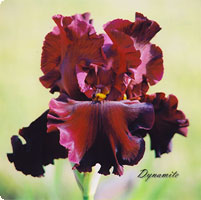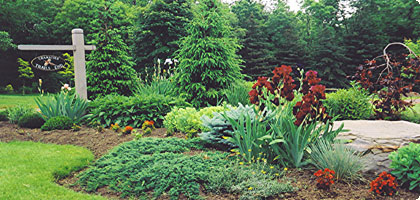| Planting Instructions
Iris plants can be planted at any time during the growing season. However, you will get the best results using potted plants in the spring and bare root rhizomes in mid summer. Bare-root plants are more economical and most large growers offer only this choice.
Bearded Iris are extremely hardy plants offering bloom from early May to late June and sometimes ‘’re-blooming’ again in the fall. They have excellent foliage and look great in the landscape, particularly with today’s popular grasses.
They love the sun and like most grasses require little water, perfect for low water ‘Xeriscaped’ landscapes.
Location, Location, Location
Choose a spot with at least 6 hours of full sun in well drained soil.
Potted Plants (Spring & Summer)
Carefully remove the plant from the pot without
disturbing the soil and plant at the same level or
slightly higher in the ground. Be careful not to add
soil to cover the rhizome, it likes to sunbathe.
Water in well and again every 3 days for a week
and then wait for it to flower.
Newly Shipped Plants (usually late August)
Unpack your irises as soon as you receive them. Check
that your order is correct. It is important to plant
within a couple of days. The sooner they are planted, the faster they
will begin to set down their roots. This will encourage better performance
next spring. If you are unable to plant immediately, store them in a cool,
dry, well-ventilated area for up to a week. If you need to store them
longer, then they should be potted in 1 gallon or larger pots in weed-free
soil.
Garden Planting (Mid-Summer)
|
 |

Dig a trench

Cover the roots
|
They may look a little wrinkled but they are ready to grow. To rejuvenate them, soak the whole plant
for a couple of hours in water. You could add starter fertilizer with rooting hormones to give them an
'extra kick'. Dig a trench with a hill in between like the photo above, place the rhizome, (thick root-like
part), on the hill at soil level and bury the roots in the trenches. Be careful not to cover the rhizome
with soil, they like to sunbathe. Water in well and again every 3 days for a week, followed by weekly
watering until they have rooted.
We encourage you to plant your Iris as early as possible to enable the the roots to establish good
growth prior to freeze-up. This will also help to prevent heaving during the colder months.
Late fall planting
In the event, you are unable to plant by mid to late summer, you may want to try over-wintering
potted iris in a dark, unheated shed or garage. We have been trying this with good success. Pot the
Iris in large pots in the fall and set them in your garden to continue growing. Make sure you water
periodically. Just as winter freeze-up begins, bring them into your unheated shed or garage. Be sure
to water lightly a few times during the winter to prevent the roots from drying. It is best to cover any
windows to help prevent heat build-up on sunny days. In the spring, prior to growth, move the pots
back outside to condition. As soon as the ground is workable, remove them from their pots, keeping
the soil ball intact, “tickle” the roots and plant in the ground.
Winter heaving
During the last couple of winters we have experienced significant thaw periods
mid winter possibly due to climate change. These temperature changes result
in a freeze - thaw cycle which is particularly damaging to newly–planted
Iris rhizomes. Prompt planting combined with mulching will help prevent heaving.
Newly (First Year) Planted Rhizomes
Vanessa is covering one of our recent Introductions, Easter Candy,
with about 9" of weed-free straw. |
First Year Planted Bed
Here we have covered the entire newly planted bed with straw. In the spring the straw will be raked in between the rows
to help act as a weed barrier. |


|
Winter Mulch Cover
A generous covering of weed free straw or a light covering of sand, compost or evergreen bough mulch would be
beneficial after the ground freezes. Dry leaves such as Oak and Beech are good coverings since they do not pack down.
Do Not use other types of leaves such as Maples since they turn slimy and prevent air circulation.
IMPORTANT: Be sure to remove all mulches in early spring before new growth begins.
|


